#finnish textiles
Text
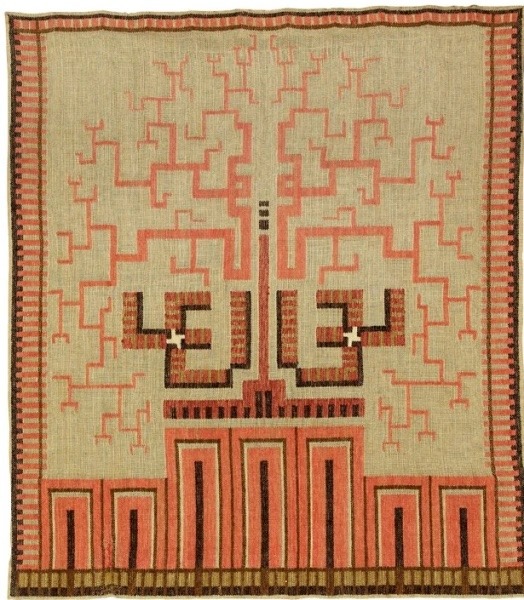
Loja Saarinen (designer/weaver)
Tree of Life Tapestry
circa 1933
#loja saarinen#tree of life#tapestry#textile art#textile#textile designer#textile design#fabric art#finnish artist#american artist#finnish art#finnish#finnish textiles#textiles#tapestries
697 notes
·
View notes
Text

between by petra lindholm, 2023, textile & pastel on aluminium, 40.5 × 48 inches
86 notes
·
View notes
Photo
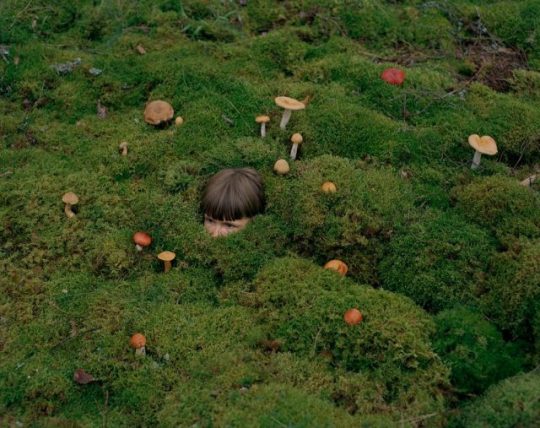

Entwined with Nature: Riita Ikonen's Ethereal Portraits of Human and Environment
#fashion#environmental art#mixed media#portrait#photography#finnish art#contemporary#textile art#riita ikonen
32 notes
·
View notes
Text
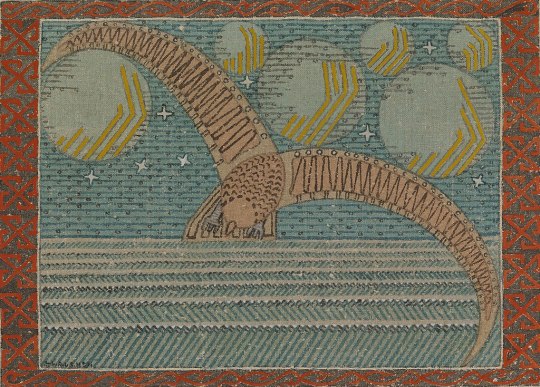
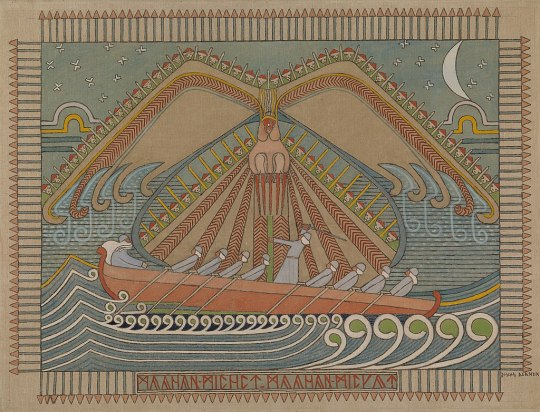
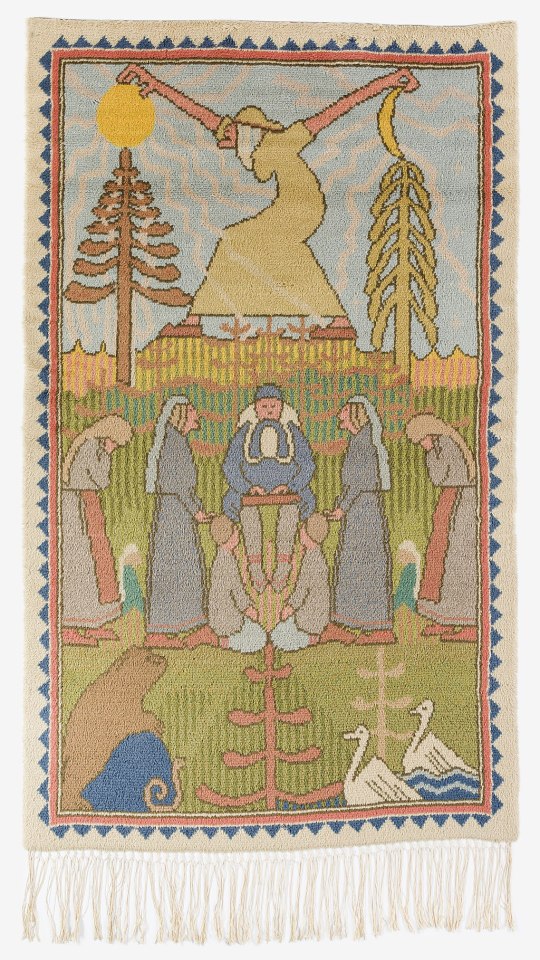
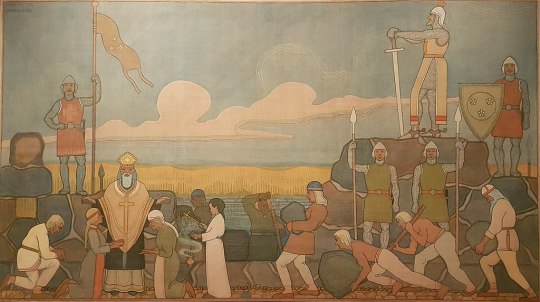


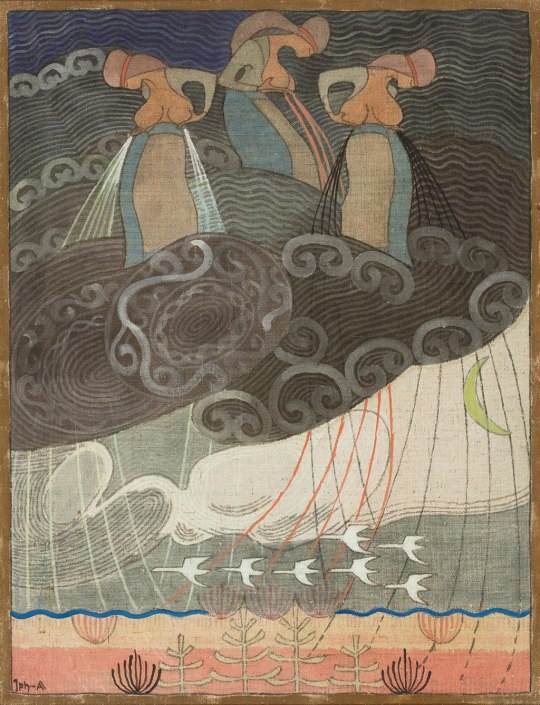

Art of Joseph Alanen (1885-1920)
21 notes
·
View notes
Text

STUDIO LOJA SAARINEN


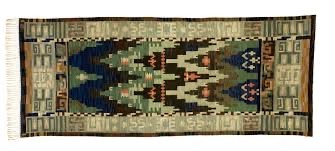
Loja Saarinen (March 15, 1879 – April 21, 1968) was a Finnish-American textile artist and sculptor who founded the weaving department at the Cranbrook Academy of Art in Michigan. She also led her own studio, the Studio Loja Saarinen. Via Wikipedia
13 notes
·
View notes
Text

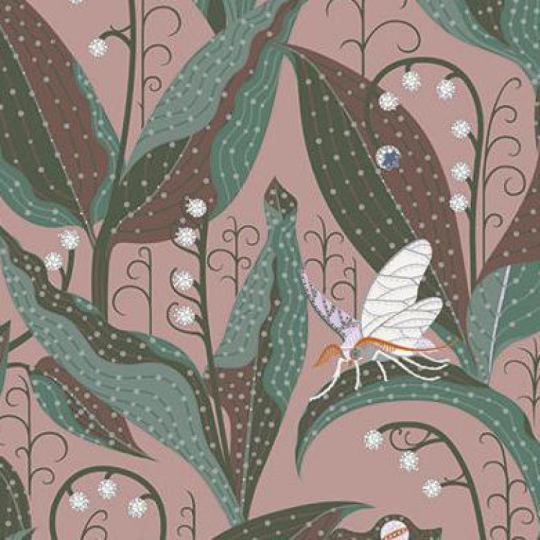
Lily of the Valley wallpaper by Klaus Haapaniemi
'An art deco inspired pattern of delicate flowers, butterflies and little frogs hiding in the leaves. Klaus Haapaniemi, one of the leading names of contemporary Finnish design, has designed a wallpaper collection full of intense colours and bold patterns inspired by the Nordic nature and mystics.'
#lily of the valley#muguet#1er mai#1 may#may day#flowers#floral#wallpaper#wall covering#pattern#surface pattern#surface pattern design#pattern design#textiles#textile design#fashion#print#printed textiles#Klaus Haapaniemi#Finnish designer
33 notes
·
View notes
Note
Hey, I noticed that in one of your posts you showed an Iron Age Finnish woman's dress. Would you happen to have a good idea of what Finnish men were wearing in that era? The information on it seems sparse. I do have a relevant book that I'm about to look through, but I'd like to hear your insight too!
Hi! Thanks for the question (and sorry for the slow answer), I do love Finnish Iron Age clothing so it's always my pleasure to write about it. I've been wanting to do a deep dive into this for a long while, so maybe I'll do at some point a post about women's dress too.
Unfortunately no one has good idea of the Finnish Iron Age men's dress (and if you find any book or other source that claims otherwise, do not trust it), since there's much fewer archaeological finds of men's dress than women's dress. The most accepted theory on why the textiles of women's dress survived surprisingly well is because of the bronze ornamentation commonly sewn into especially the fine women's dresses of the era. The bronze protected them from decomposing fully. Presumably men's dresses were not decorated similarly then. There are some finds though and we can piece together at least some kind of vague picture.
I will be discussing the period from Viking Age to Crusade Age in Finland. Viking Age is often defined to cover 800s to mid-1000s and the Finnish Crusade Age started right after the Viking Age and ended in the end of 1200s, where the Finnish Medieval era begins. Crusade Age refers to the period where mostly Swedish (also German) crusaders in the span of couple of centuries conquered lands of the Baltic-Finnic pagans. The crusades of this period targeted pagans all over eastern Baltic Sea, including Baltic-Finnic Karelians, Livonians and Estonians, and Baltic peoples, and the Scandinavia too, where Sámi people were targeted. After that the Finland and Sápmi were colonized by Norse people and stayed that way untill Finland was transferred under Russian rule, but to this day Sápmi still stays under colonial rule, including Finnish colonial rule. The current Finland was very multicultural area, mostly populated by Finno-Ugric peoples, including Sámi people, Karelians and various Finnish peoples.
It's important to understand that even just Finnish peoples where not homogeneous, but had distinct, yet of course strongly related cultures. These were Finns (suomalaiset) (yes most people we now call Finns were not in fact called that) in the coast of southwestern and western Finland, Tavastians (hämäläiset) in central-western lake-Finland and Savonians (savolaiset) in central-eastern lake-Finland. This means we can't mix findings from all over Finland to reconstruct a dress without evidencing that all the elements were actually used in one place. These three tribes had broadly similar base for their clothes, but distinctive jewelry and detailing. The big divide was and has always been between eastern and western Finnish peoples. This is because western Finnish people were in close contact through the sea with Norse people and southern Baltic-Finnic peoples, while eastern Finnish people, Savonians mostly, were influenced a lot by their proximity with Karelians. Another dividing factor was the very different environmental conditions between western and eastern Finland. The Finnish coast especially in west is very flat and fertile land, while the lake area, especially in eastern Finland is very rocky, hilly and quite infertile. The main way it effected clothing differences was that western Finland being more wealthy had more elaborate clothing. Tavastians in both occasions fall quite in between, but they tended to be more in the western cultural camp.
My most important sources are a study by a doctor of cultural anthropology, Jenny Kangasvuo, Savon historia I (Savonian history) digitized and open sourced here and the digitized archeological collection of Finnish Heratage Agency. They are all in Finnish so not very useful for most people unfortunately.
Finnish Men's Dress in Viking and Crusader Ages
The basic garments men wore were broadly similar as women. They wore a shift/shirt, knee or above-knee length dress, cloak, belt, shoes and some kind of headwear. Wool was used most commonly, though the shirt would sometimes be linen too. Even evidence of silk has been found in some western Finland graves. I would assume that would be from a dress of some great man, who traveled to gain riches, possibly with vikings. Embroidery and decoration with metals was a typical feature of the whole Eastern Baltic Sea area. In Finland during this period bronze was the most common decorative metal, but silver was used too. Decorative elements were usually woven with small bronze spirals into all kinds of patterns. Here's examples from the reconstructed Ravattula's dress (Finns) used by women.
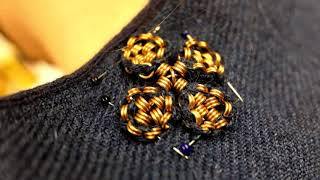

Shirt
The shirt (in Finnish shift of both women and men was called shirt) was basically a long shirt or under dress. We can assume it was similar to those of women's except shorter since the dress men wore was shorter too. They were made from wool or linen, I would assume wool was used in winter and linen in summer, when linen was even available. The neckline had a cut and closed with a bronze brooch. Horseshoe brooch was common. The first one is a quite typical bronze horseshoe brooch with a bit of ornamentation from Salo (Finns). The second one is from Tuukkala, (Savonians), it has exceptional ornate detailing and is uncommonly silver, not bronze. The third picture has two quite uniquely ornamented horseshoe brooches, first from Köyliö (Finns), second from Kurikka (Finns).
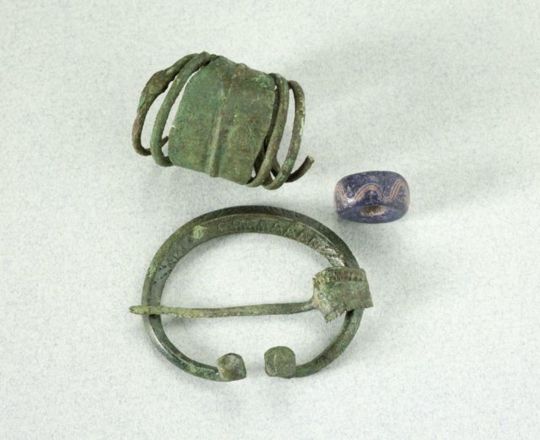
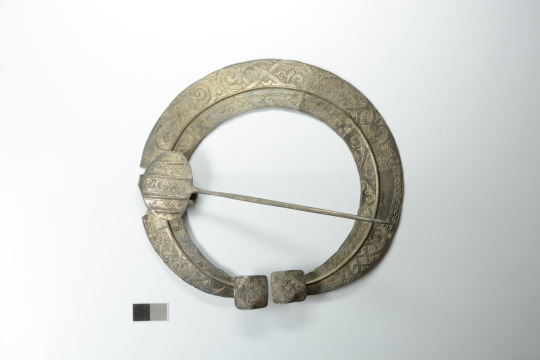
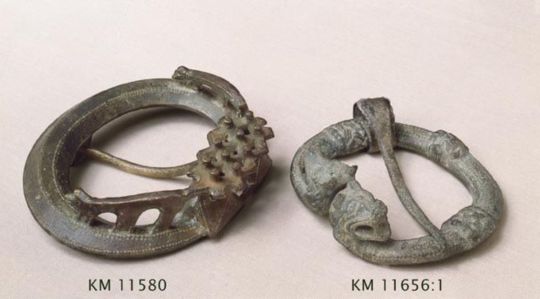
Legwear and footwear
Very little of men's legwear has survived and it's unclear weather men wore pants or separate pant legs, leg wraps or perhaps long socks. Evidence of strings decorated with bronze spirals and tablet woven band has been found in leg area of men's graves. This could mean that they wore either leg wraps, long sock or some sort of pant legs that needed to be secured with string or band under knee. Women used strings and tablet woven tape to secure leg wraps and socks, which I think supports that theory. Sometimes both bronze decorated string and tablet woven band was found in the leg area, which would still be explained by this theory, since it was common to decorate the ends of the bands with bronze decorated strings. Here's an example of sock bands just like that from the earlier mentioned reconstruction of the Ravattula's women's dress. Since men's dress was shorter, I think it would make sense if they still wore some kind of pants or separate pant legs with socks or leg wraps like that.
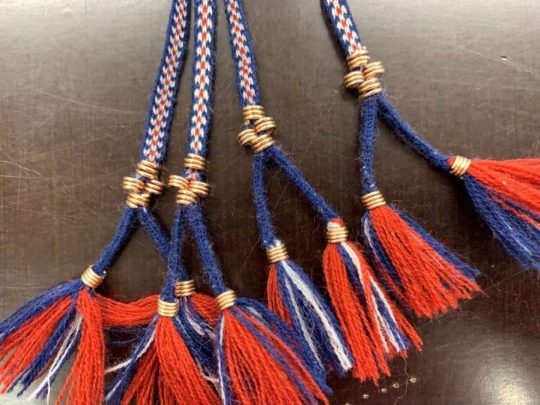
However, the strings and bands could have also been part of the shoes. Everyone probably wore similar shoes - laced leather shoes with a bit of pointed end. They might have been short or ankle length and the lacing was done with either leather cord or tablet woven band, which would also explain the findings. Socks or feet wraps would have been used in them, and straw or wool could be added as filling for warmth. Here's a pair of traditional Izhorian shoes from Estonia from early 1900s, and a pair of traditional Sámi shoes. The designs were likely roughly similar in Viking and Crusader Ages, though obviously more simple, and it's probable that Finnish shoes very something like that too. Here's a 1893 drawing of what findings of shoe material from Korpiselkä (Savonian or Karelian) might have looked like. Considering the quality of archaeology of that time, copious amounts of salt should be applied. And finally as a fourth picture there's reconstruction shoes from Ravattula's dress.


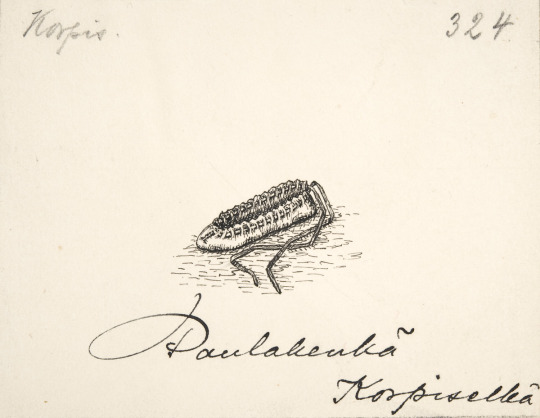
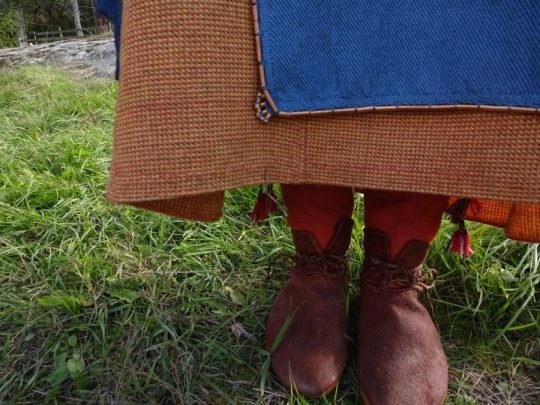
These are not necessarily mutually exclusive theories. The lacing of the shoe could have been laced up the leg and used also to secure either sock or leg wrapping, or they could have been separately secured in ankle and knee respectively.
In some graves twill fabric has been found in the leg area. It could be part of pants or for example leg wrapping, which was often made of twill. One theory about pants is that they were similar as some findings in Sweden, where fairly tight pants made of twill were secured at the hem with buttons similar to cuff studs. These kinds of cuff stud buttons are quite a common find in Finland and some have been found in men's graves close to legs.
Dress
Again there's not much findings of dresses, but a little more perhaps. It was usually from wool. The shape was either a tunic or an open coat. In Karelia there's findings of men's dress suggesting tunics thicker than women's dresses and made from sarka, a type of broadcloth. On the other hand, in Masku (Finns) they found buttons in a row on top of the torso, which suggest a coat closed with buttons. The first picture is a drawing of the grave find. Similary coak closing amounts of buttons have also been found in other places in western Finland. This suggests that Finns and probably Tavastians too wore long coats buttoned to the waist and Savonians wore tunic of Karelian influence. Below there's couple of version of what might this western Finnish men's coat dress could've looked like. The first is an imagined version of the coat based on the Masku grave finds, second is just as imagined version based on Eura (also Finns) grave finds.
Take these "reconstructions" with a strong dose of salt. These are more artistic reconstructions than scientific, since there's not enough material and too much guesswork needs to be done. And because we can see in the Masku grave drawing right here that the other deceased has a large buckle to (probably) close the shirt (to be fair, it could for a cloak too), like was typical, I find it implausible that the coat neckline would be small and round covering the buckle. If you make a decorated big buckle, I assume you want to show it. I would find a v-neckline more probable. It's also easier to make without wasting expensive fabric.

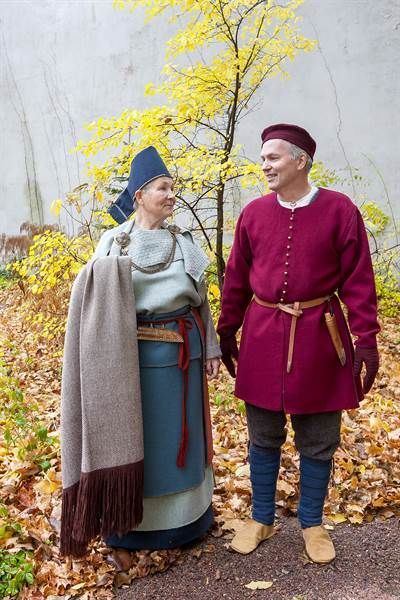

The buttons are interesting. There were what you would imagine - your typical buttons made of bronze like seen in the first artifact from Hattula (Tavastians). But then there was silver jingle bells used as buttons, found for example in both Masku and Eura graves, Eura findings pictured below.


It's possible, even probable I'd say, that the hemlines of men's dresses were finished with tablet weaving patterns, like women's dresses. Also I would assume the pattern of the men's dress (and shirt) was mostly similar to the women's underdress/shirt patterns. So here's couple of different reconstruction patterns for women's dress. Different historians have made different interpretations of the patterns, so it's very much undecided what it really was like.
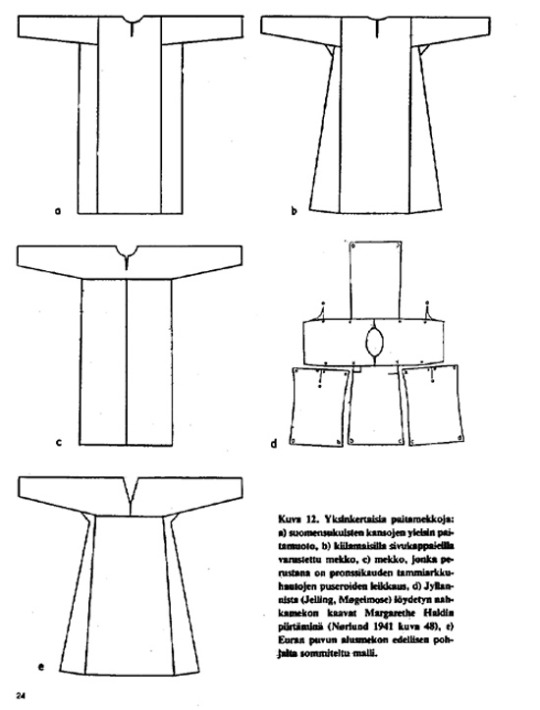
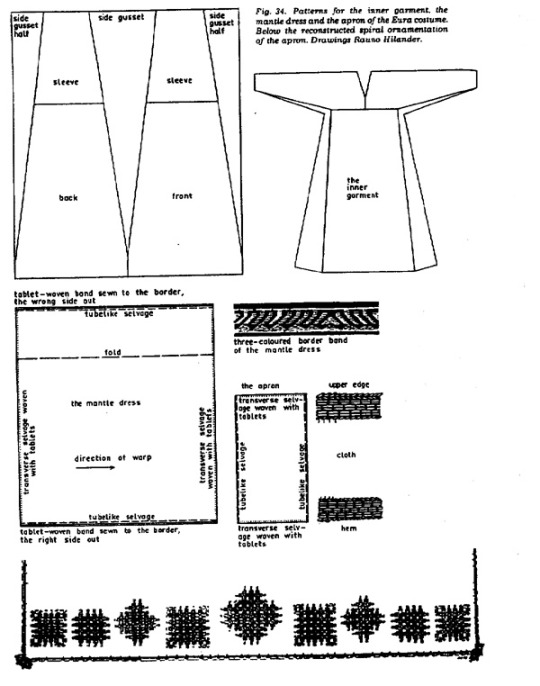
Belt
This is likely the most ornamental part of men's dress. They could be made out of leather or tablet woven band. And there's another east-west cultural divide here. Karelian belts were made out of leather, were usually 1,5-2,5 cm wide, decorated with iron or bronze studs and had a buckle made out of iron or bronze. These types of belts have been found in Savonia too, for example in Tuukkala grave find, which you can find very cool pictures of in this photo documentation of the dig in pages 173-175. In western Finland a "hela" belt was the common style. I don't think there's a world for hela in English. It's a sort of decorative lamella, small metallic plate (not necessarily square but often so) attached to fabric or leather with studs or sewing. Hela belt came from the Permians of Kama river, who were one of the many Finno-Ugric peoples who used to populate much of European side of Russia. Karelians lived closer to Permians, so you might think Permians would influence eastern Finland more, but my theory is that the costal Finns, who frequently joined viking crews and at least were in close contact with merchants including vikings, who would travel along the eastern route through the eastern European rivers, where they could go all the way to Kama river or at least meet traveling Permians. Here's yet another Finnish source more on the Finno-Ugric people around Kama river.
Anyway, hela belt was made of leather and filled with small decorated lamellas, often in square shape, but various other shapes too, like animal ornamentation. In this period hela belt helas were bronze. First image is a nice full set of hela belt metal pieces found in Pirkanmaa (Finns). Second is an older example, right before Viking Era, from Vaasa, costal settlement, (Finns), depicting a very Permian style. The third one is a lion hela found separately in Pälkäne (Tavastians). They are also found in Tuukkala, showing that both eastern and western cultural influences were present there at the same time.

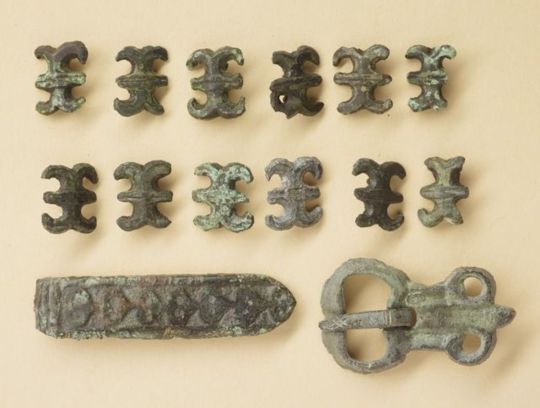
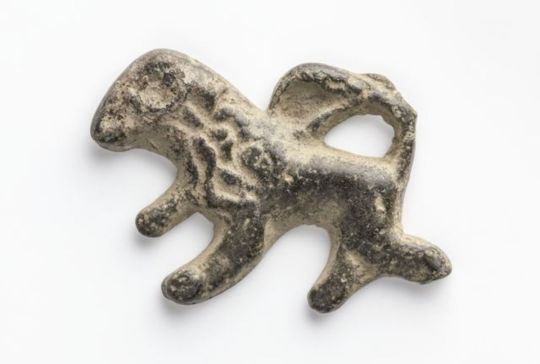
Another western Finnish belt type for men had intricate tassels decorated with bronze spirals hanging on the waist at the end of the belt. They could be made out of leather or tablet woven band. First image depicts a reconstruction of such tassel. Belts in east and west would have strap dividers to hang straps for things like purse, knife and sword. The first picture above has couple of those, but the second picture below has two more of them in more detail in the middle of the picture. These finds are from Lieto (Finns).


Cloak
Like women's cloak, men's cloak was woolen and either a square or trapezoid. Cloak is yet another east-west divide. In western Finland men's cloaks have embroidery with bronze spirals. They in fact appeared earlier in men's cloaks (in 900s) than in women's cloaks (1100s). They were also a little different in men's cloaks. The spirals and the patterns themselves were bigger and the fastening thread itself was also used for the pattern creation, unlike in women's dresses, where the thread was mostly covered. In eastern Finland there has been no finds of bronze decorations in men's cloaks, mostly only cloak brooches have been left of them. Unsurprisinly same applies to Karelia. This also means there's very little fabric left too. There's one exception. In Tuukkala (Savonians) they found a piece of fabric probably from men's cloak, though it could be from a men's dress too. It was striped, with possibly white or brown base and wide stripes of red, blue and yellow. So perhaps eastern Finnish cloak was not non-decorated, but the decoration was in the fabric pattern. Unfortunately it's hard to know how common fabric like that was, when so little of it is left.
Accessories
It's safe to assume men too wore some type of headwear, but none of those has survived. It probably means it was entirely made out of fabric whatever it was. Some type of hat or cap was certainly used in cold weather at the very least. Tablet woven headband was also possible option for not too cold weather.
In Tuukkala there was couple of interesting jewelry finds too. Two graves had a necklace type mostly found in Karelia. It was birchbark tape covered with nettle fabric and had square helas sewn into it. There were also more typical Finnish necklaces made of beads and bronze spirals.
Razors have also been found with men in their burials, so we can assume shaven faces or at least trimmed beards and moustaces were fashionable.
#dress history#historical fashion#historical clothing#fashion history#history#iron age dress#finnish iron age dress#finnish history#archaeology#answers#anon
221 notes
·
View notes
Text

Dress Collection 1
I have shared these before but they have new thumbnails (I'm updating all my CC thumbnails eventually so that they'll *~match~*). Marjaana and Eveliina dresses have updated textures AND renamed files, so if you re-download them, delete the old files manually.
All dresses are BGC, have proper LODs, shadow/normal/specular maps, and Maxis Match polycounts. Feminine frame only! Links to their original posts under the cut.

No ads or other nonsense!
Patreon (free) // Curseforge
TOU in a nutshell: I’m pretty chill about people using the content I’ve created to create something new, just credit and tag me (on tumblr) but don’t put the new stuff (or my original) behind any kind of paywall or sketchy links. Thank you!

For anyone who likes, reblogs, comments, creates a lookbook, recolours... Thank you! ♥
@maxismatchccworld @mmfinds @public-ccfinds @mmoutfitters

From left to right:
Marjaana Dress
- 36 swatches (21 pattern, 15 solid)
- The patterns I used are prints by Finnish design houses/textile manufacturers
- original tumblr post
Eveliina Dress
- 16 swatches 80s/90s patterns
- patterns by various freepik creators
- original tumblr post
Suvituuli Dress
- 14 swatches (9 pattern, 5 solid)
- originally shared with matching earrings, see link below
- original tumblr post
Poutapilvi Dress
- 9 solid colour swatches
- original tumblr post
Kuunsilta Dress
- 5 solid colour swatches
- original tumblr post
82 notes
·
View notes
Photo
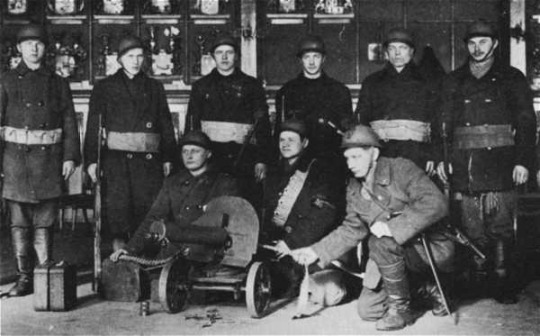
On this day, 27 January 1918, revolution broke out in Finland as workers took over Helsinki with many of the country’s other large towns following in the next few days. Victor Serge recounted that: "the Red Flag was hoisted over the Workers' House at Helsinki. The city was rapidly captured, and the Senate and government fled to Vaasa. In a few days, almost without resistance, the Reds took over the largest towns, Abo, Viipuri and Tammerfors, and the whole of southern Finland… They introduced workers' control over production, which was relatively simple given the marked concentration of key industries: wood, paper and textiles. They were successful too in stopping sabotage on the part of the banks. Public life and production very soon resumed a practically normal existence." The ‘People’s Republic of Finland’ instituted numerous far-reaching reforms, including women’s suffrage, workers’ control, a maximum eight-hour working day, abolition of the death penalty, abolition of the old mode of land distribution and the emancipation of domestic servants and farmhands. However, to end conflict with the Central Powers in World War I, Finland, along with other territories, was surrendered to Germany by the Russian Bolshevik government in the March 1918 treaty of Brest-Litovsk. The following month counterrevolutionary White forces drowned the revolution in blood, slaughtering thousands of workers and socialists, and throwing tens of thousands more into concentration camps. According to Serge, for the rich the White terror was "a historical necessity. The victorious propertied classes are perfectly aware that they can only ensure their own domination in the aftermath of a social battle by inflicting on the working class a bloodbath savage enough to enfeeble it for tens of years afterwards. And since the class in question is far more numerous than the wealthy classes, the number of victims must be very great." Pictured: Finnish Red guards, 1918 https://www.facebook.com/workingclasshistory/photos/a.296224173896073/2195681690616969/?type=3
155 notes
·
View notes
Text


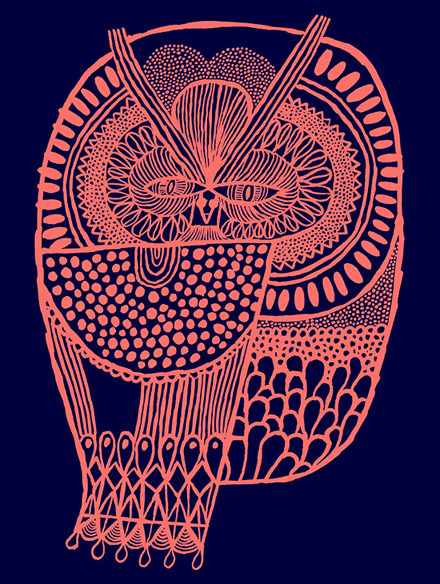




Aino-Maija Metsola (b. 1983) is a visual artist and designer based in Helsinki, Finland.
She uses a diverse selection of techniques from watercolour to ink, collage, markers and gouache to craft paintings, patterns and illustrations for various surfaces including textiles, clothing, tableware, stationery and books.
Among Metsola’s most recognisable works are the numerous pattern designs created for the renowned Finnish design house Marimekko.
Aino-Maija Metsola graduated from the University of Art and Design Helsinki in 2008.
42 notes
·
View notes
Text

Loja Saarinen and Eliel Saarinen (Designers)
Rug No. 2
November 1928 - February 1929
@ The Detroit Institute of Arts, Detroit, Michigan. Photograph by Dirk Bakker.
#loja saarinen#eliel saarinen#rugs#rug design#rug designer#carpet design#textile art#textile artists#textiles#textile artist#textile designer#finnish textiles#textile design#american textile#textile#textile arts#1920s art#1920s#1920s style#1920s textiles
13 notes
·
View notes
Text



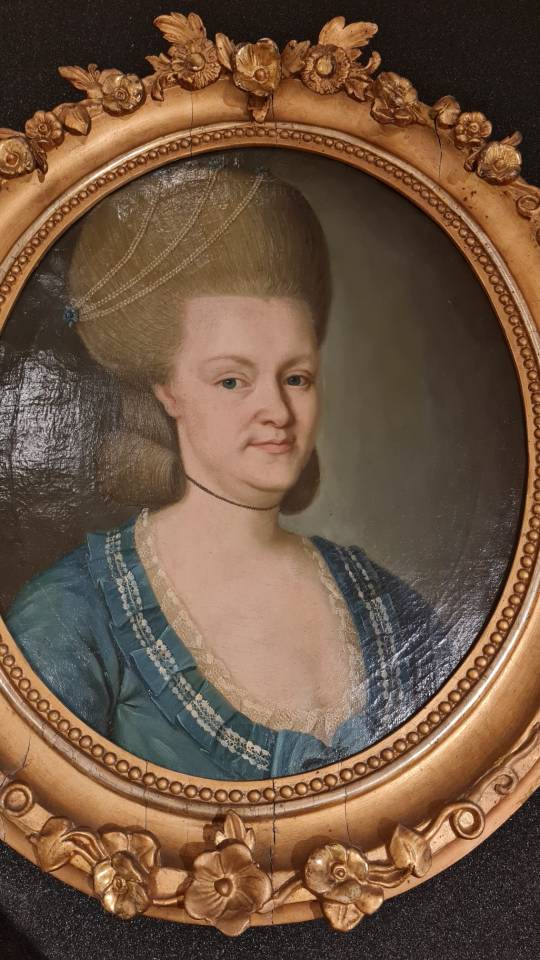
This is about bobbin lace making, so if you were expecting news about hot new video games, then I'm sorry.
I've finished - for now - working on my 18th century Rauma Museum / Annaberg 9090 tulle lace pieces, and yesterday I started working on something that's a bit of a collaboration between my textile conservation friend and my bobbin lace teacher who is also the same person who has documented the Rauma lace collection into a book, so I seem have landed in the middle of a historical archeology project!
Yesterday I had the utter privilege and delight to receive the mynster (pattern) for an 18th century lace trim painted to great enough detail in this portrait from the Finnish National Museum archives.
My wonderful teacher had many theories about the many qualities of the lace possibly originally used in the original dress, but as we know, portraits can be untruthful, or make details look better than they do, but she had solid theories on the tightness of the twist in the original threads and their material, and I'm to start the hands-on testing of these theories, which I just happen to find quite exciting.
What I find very interesting in recreating history is that you keep on discovering how stunningly more wide open everything was before industrialization, because materials weren't produced to spec in massive quantities.
14 notes
·
View notes
Video
vimeo
Woven Beauty – Four centuries of Finnish ryijy textiles
Ryijy is a woven Finnish long-tufted tapestry or knotted-pile carpet hanging. The name ryijy originated with the Scandinavian word rya, which means "thick cloth". The decorative ryijy rug is an art form unique to Finland.
The use of color and pattern is especially unique to the Finnish ryijy. Dating back to the 18th century, a ryijy was often used as a prayer rug during wedding ceremonies; the tapestry was then hung for display in the couple's home. (x)
60 notes
·
View notes
Text
Called Infinna, the fibre is already being used by global brands including Patagonia, H&M and Inditex, which owns Zara. "It's a premium quality textile fibre, which looks and feels natural - like cotton," says Mr Alava, rubbing his own navy blue tee between his fingers. "And it is solving a major waste problem."
Around the world, an estimated 92 million tonnes of textiles waste is created each year, according to non-profit Global Fashion Agenda, and this figure is set to rise to more than 134 million tonnes by 2030, if clothing production continues along its current track.
To the untrained eye, samples of Infinited Fiber's recycled fibre resemble lambswool; soft, fluffy and cream coloured. Mr Alava explains that the product is produced through a complex, multi-step process which starts with shredding old textiles and removing synthetic materials and dyes, and ends with a new fibre, regenerated from extracted cellulose.
This finished fibre can then simply "hop into the traditional production processes" used by High Street brands, replacing cotton and synthetic fibres, to produce everything from shirts and dresses to denim jeans.
Much of the science involved in making the fibre has been around since the 1980s, says Mr Alava, but rapid technological advancements in the last few years have finally made large-scale production a more realistic possibility.
In parallel, he believes High Street brands have become more focused on "really honestly looking for changing their material usage", while millennial and Gen Z consumers are increasingly concerned about shopping sustainably. "They are different animals, different consumers, to people my age," he laughs.
The company has already attracted so much interest in its technology that it recently announced it was investing €400m (£345m; $400m) to build its first commercial-scale factory at a disused paper mill in Lapland.
The goal is to produce 30,000 tonnes of fibre a year once it's operating at full capacity in 2025. That is equivalent to the fibre needed for approximately 100 million T-shirts.
"I think the impact could be quite big, if you think about the whole textile system, what exists currently and how much textile waste that we have," argues Kirsi Niinimäki, an associate professor in fashion research at Aalto University, a few blocks away from Infinited Fiber's headquarters.
"It's a really good example of actually how we can 'close the loop'… really begin to move to a circular economy."
Infinited Fiber's growth is tied into a wider vision in Finland, which wants to become Europe's leading circular economy, with a focus on reusing and saving resources. In 2016, it became the first government in the world to create a national road map designed to help reach its goal.
Several other Finnish start-ups are looking at ways to produce new textile fibres on a big scale, while also cutting down on harmful emissions and chemicals. These include Spinnova which, from its textiles factory in Jyväskylä, central Finland, transforms cellulose from raw wood pulp into ready-to-spin fibres.
Spinnova's yarn is attracting plenty of global attention and has so far been used by brands including upmarket Finnish clothing label Marimekko, and outdoor wear firms North Face, Bergans and Adidas, which recently used it in a limited edition midlayer hoodie designed for hikers.
Elsewhere in Europe, there are a range of other companies developing technologies to create more circular yarns, including Swedish startup Renewcell, and Bright.fiber Textiles, which plans to open its first factory in the Netherlands in 2023.
But experts say there are a range of challenges facing these new fibre brands as they plot their expansions.
Ms Niinimäki underlines that the clothing manufacturing sector has, until recently, been slower than many other industries when it comes to embracing sustainability, which could set the tone for a slower transformation than companies like Spinnova and Infinited Fiber hope.
"It has been so easy to produce the way that we have been producing, and just to move towards more effective industrial manufacturing on an increasingly bigger scale," she says.
"There hasn't been a big pressure to change the already existing system." However, she is hopeful that, in the European Union at least, new rules aimed at ensuring clothing manufacturers focus on more sustainable and durable products will speed up "a change in mindsets".
Another issue is whether clothing brands will be able to pass on the additional costs of their new high-tech production techniques on to consumers, especially at a time when the cost of living is spiralling globally.
Adidas' latest limited edition hoodie produced with Spinnova fabric costs €160 (£137; $160) to buy online in Finland, at least €40 more than most of its other technical hoodies.
"Fashion is a complicated area, because even if people are saying that they are environmentally aware, they don't always act rationally," says Ms Niinimäki. "There's also this kind of emotional side when you talk about fashion consumption, and of course, the price is also linked to that."
While both Infinited Fiber and Spinnova insist their business plans look holistically at all aspects of production - for example using renewable technologies to power their factories - climate campaigners argue it is still too early to accurately estimate the net effect of these new techniques on carbon emissions.
"Pulp and other alternative fibres can provide diversity for sourcing textile materials and therefore lessen the burden caused by production of more traditional textile raw materials such as cotton," says Mai Suominen, a leading forest expert for WWF. "However it depends on the use of energy, all the processes they use and how they use waste materials."
Most importantly, she argues, simply slotting more sustainable fibres into the multibillion dollar fashion industry won't be enough to combat climate change, if we keep making and buying clothes at the current rate.
There is no sustainable development unless the overall natural resource consumption is radically decreased to a level that fits within planetary boundaries," she argues.
But within the Finnish fibres industry there is a sense of boomtown optimism that the increased use of recycled or reimagined fibres could be an important part of the jigsaw in the battle to limit climate change.
"The fast-fashion companies who have been kind of creating certain parts of the problem are highly interested in new technologies," says Infinited Fibers chief executive Petri Alva. He believes that if investment continues, the recycled fibres could become mainstream within ten to 15 years.
#textiles#fashion#fashion industry#sustainable fashion#recycled textiles#closed loop economy#artificial fibres
100 notes
·
View notes
Text


Ilona Jalava, Finnish Textile Artist, 1878-1960
Rug, 1921
#bornonthisday Ilona Jalava (b. Jan 27, 1878 Helsinki - Feb 21, 1960). Jalava's parents were lecturer Antti Jalava and Alma Sofia Floman. Jalava attended a girls' school, studied at the Ateneum and the Helsinki Craft College. She worked as a textile artist and was a member of the board of the Helsinki Crafts Teachers' College and the Tellervo Home Industry Association. She published her father's biography. Via Wikipedia
Follow Taidehalli for more Finnish Art & Craft:
https://www.facebook.com/taidehalli/
#womensart #artbywomen #FinnishArt #FinnishFemaleArtist #IlonaJalava
#Finnishtextileartist #Helsinki #Taidehalli
2 notes
·
View notes
Text

mariana muravito
“Weaving requires that one puts their heart into it, and it also demands patience. It is also a manifestation of playfulness and joy, as the technical act of weaving is not substantial; vision is”, Inka Kivalo (b. 1956) is one of the leading names in modern Finnish textile art.
17 notes
·
View notes